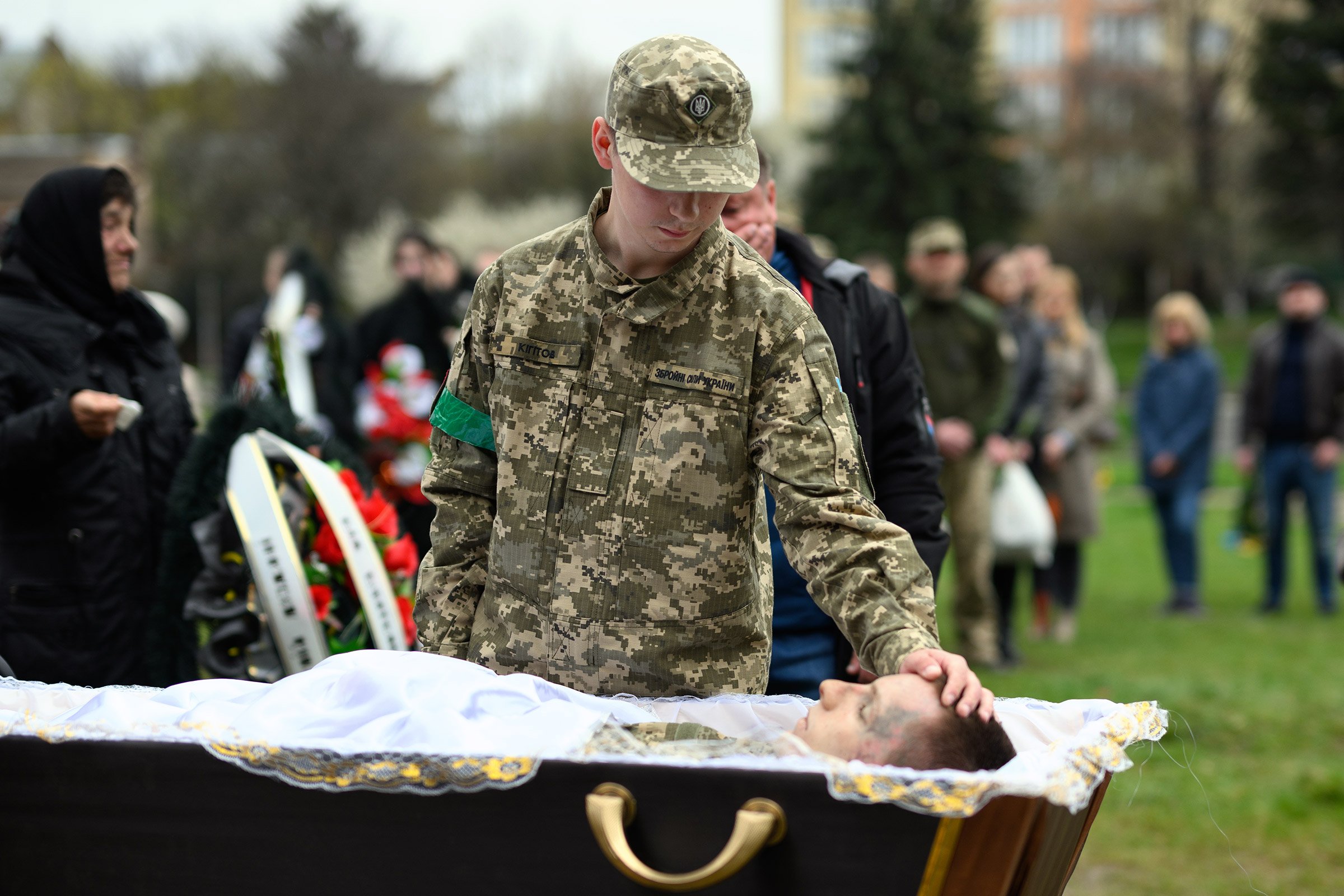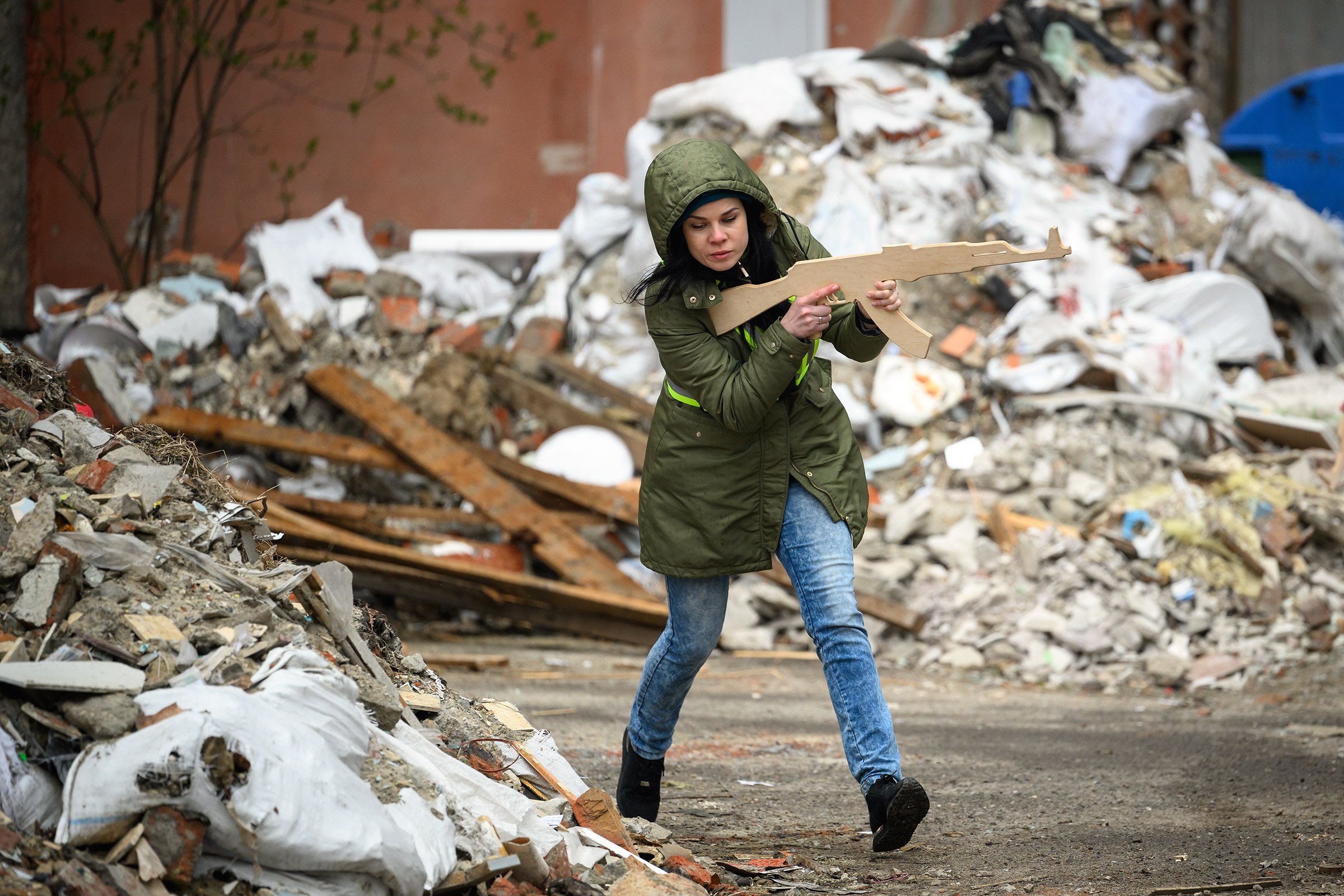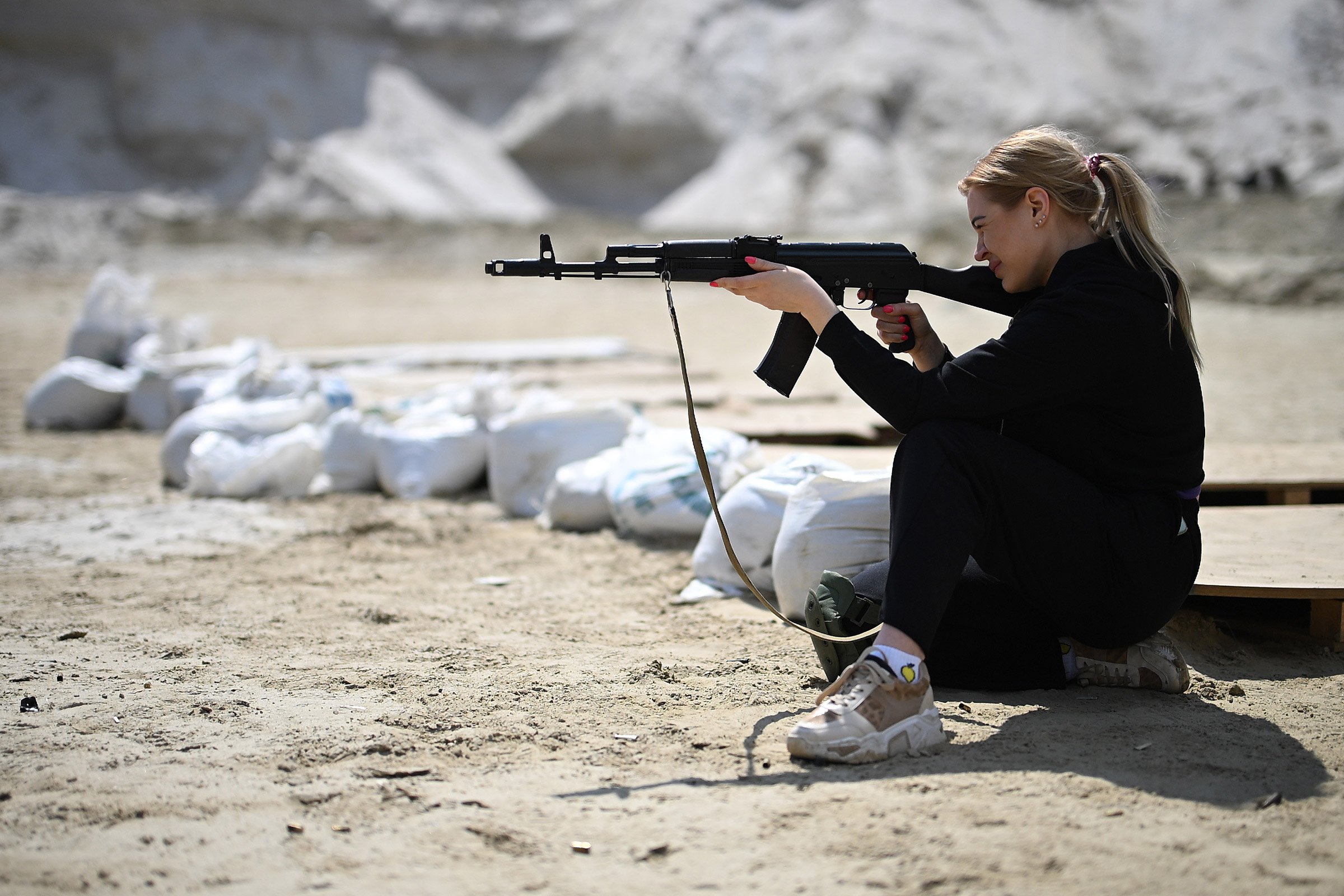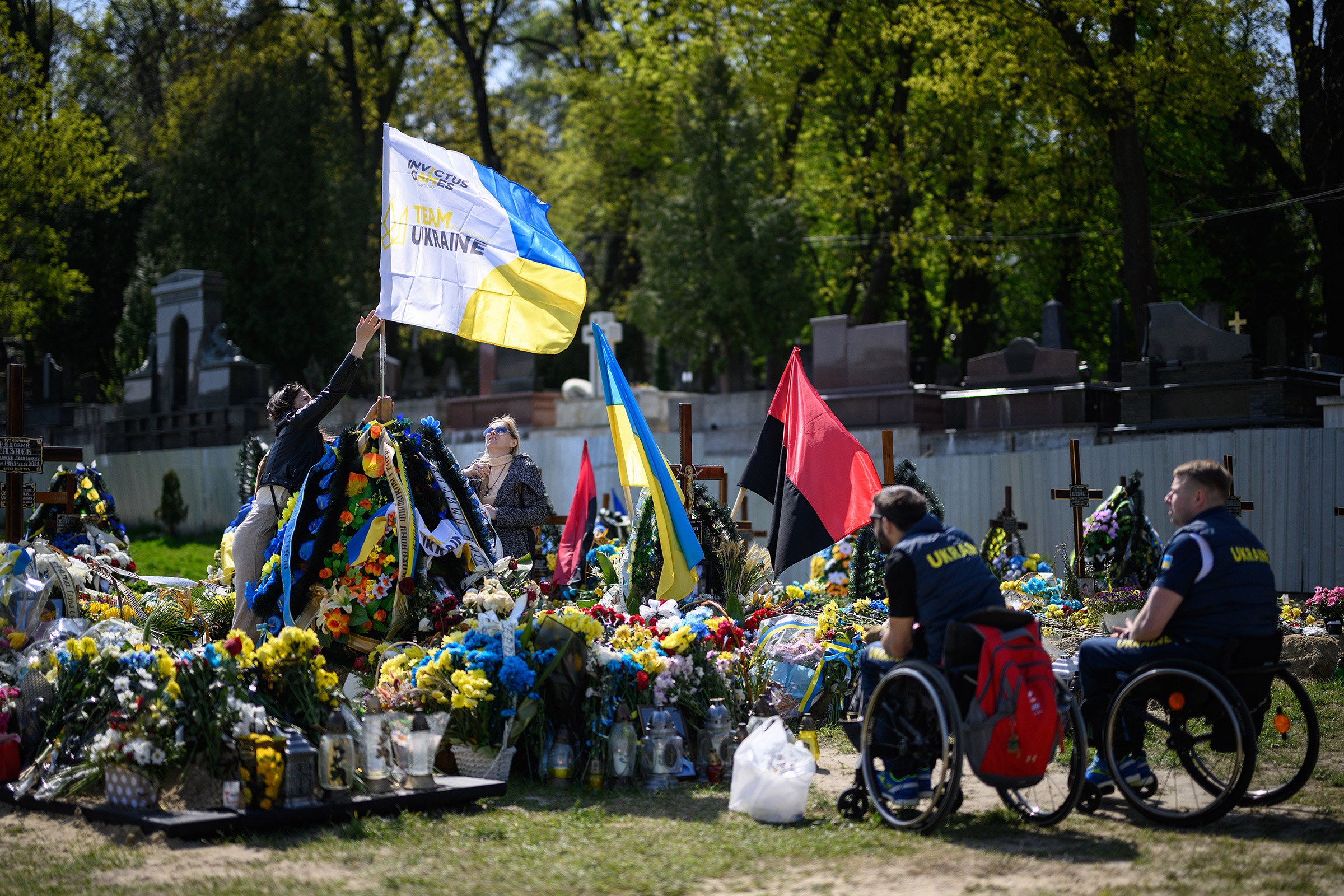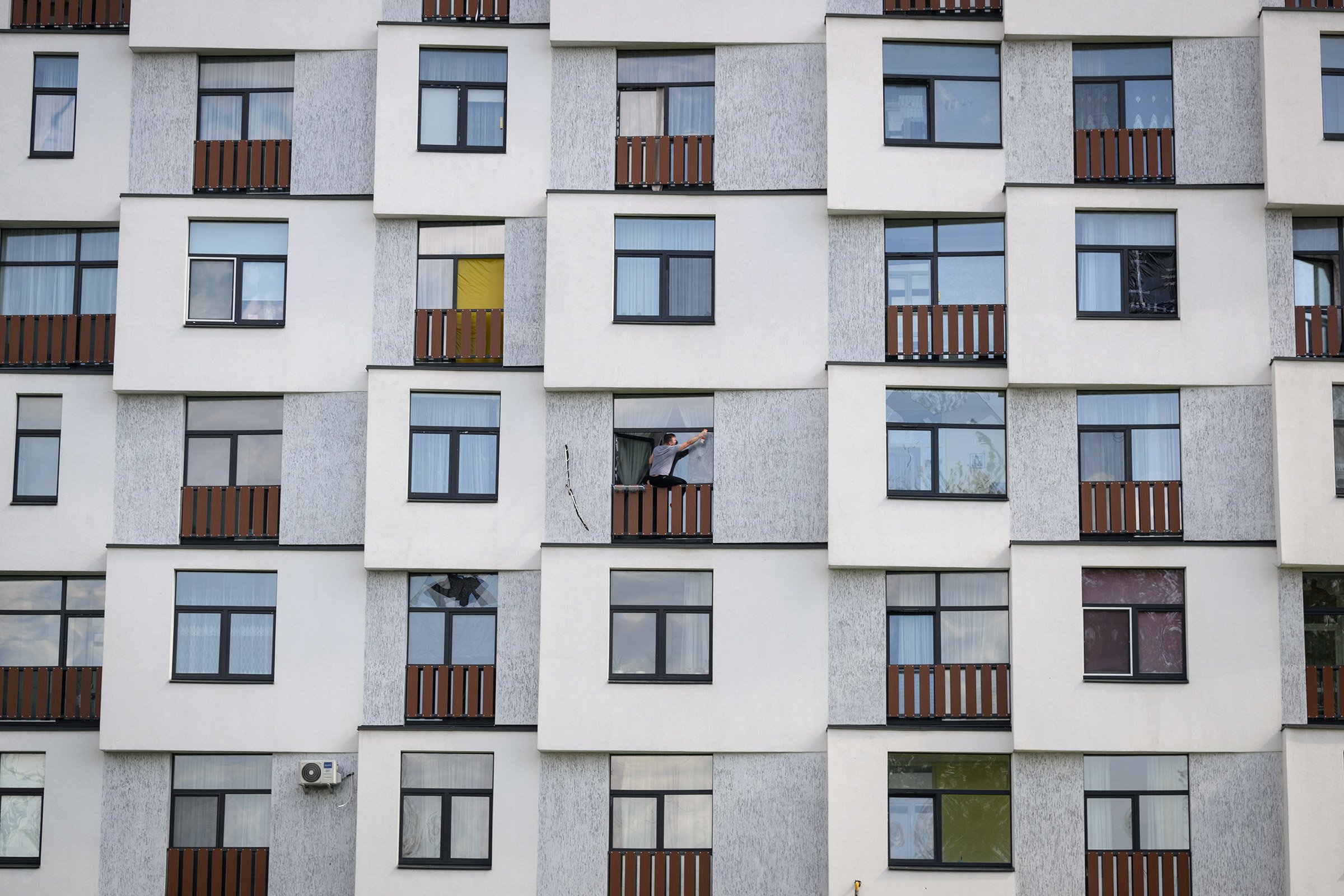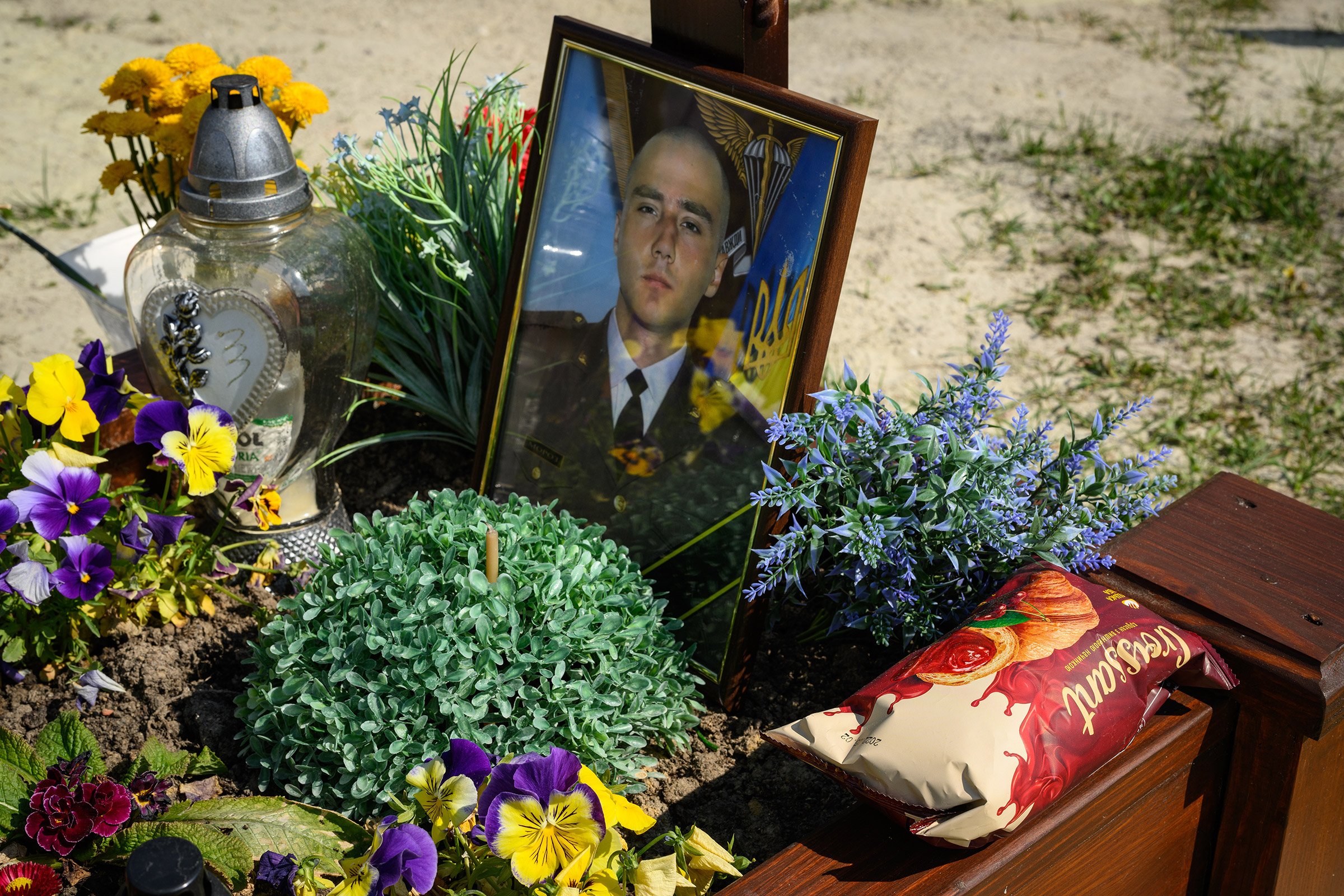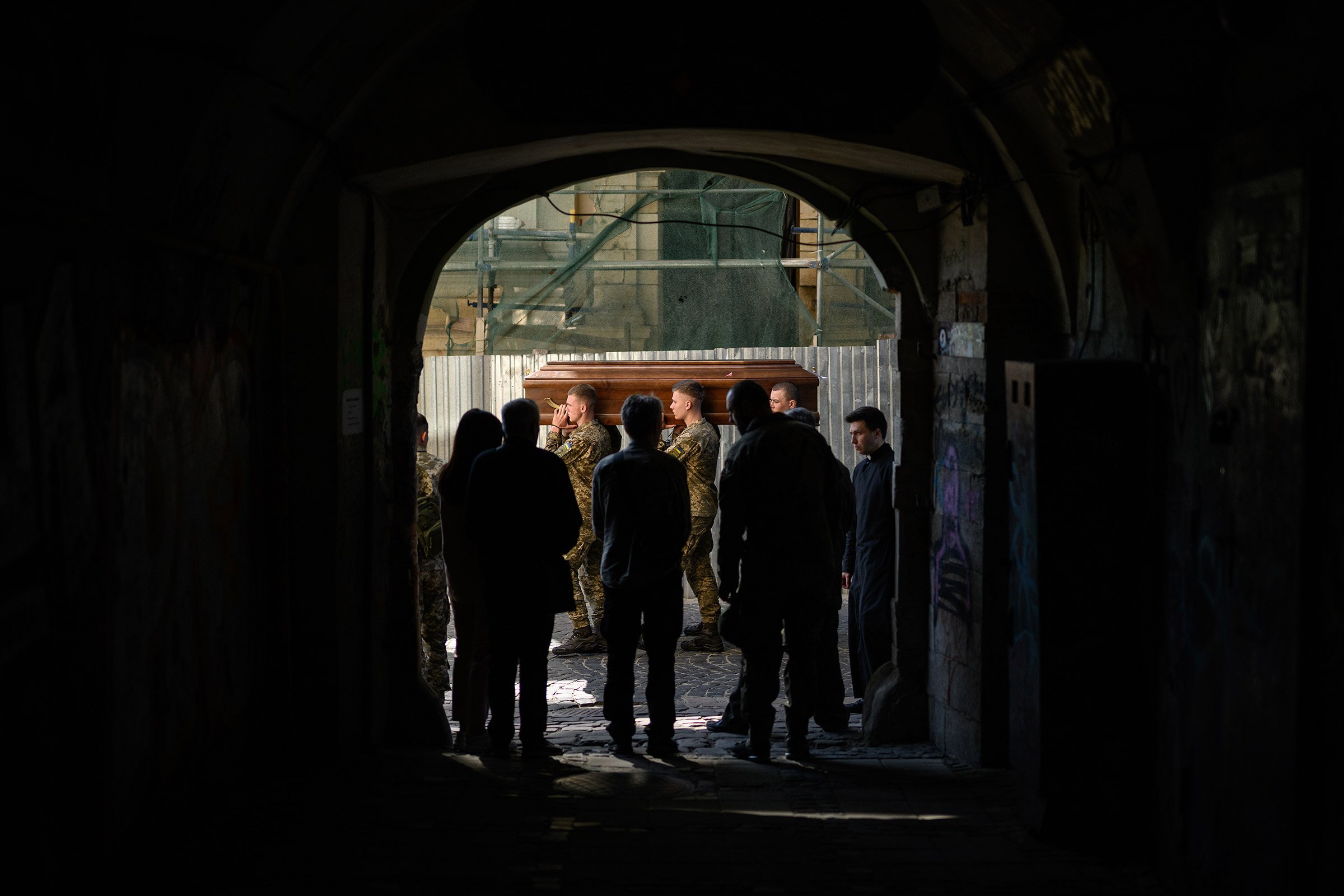The Russian Invasion of Ukraine
CONTENT WARNING: THIS POST CONTAINS IMAGES OF FUNERALS AND DEATH WHICH MAY CAUSE UPSET.
The holiday was over. Our bags were packed and we were taking a last look at the pool before our taxi arrived, when my phone rang. “When’s your flight?”, asked a member of the editorial team back in London. Quickly clearing up that she wasn’t referring to my flight back to the UK, but a flight to Ukraine, I found myself very quickly back in work mode.
The latest Russian invasion of Ukraine began on 24th February 2022, a huge escalation of a conflict that began in 2014. Colleagues at Getty Images had been in country since the start but a rotation system was now in place, allowing photographers the chance to spend enough time covering the story to get to grips with it, without too much burn out. It was agreed that month-long stretches would become the aim so on April 17, I flew out to Ukraine via Poland, to replace my US colleague Joe Raedle.
Walking across the border, I was picked up by Dominik, a young man who would prove to be so much more than just a driver and translator during my stay. Never having worked with the media before the invasion, he proved absolutely invaluable with local knowledge, chasing story details, and following me as I worked, gathering all the names and details of those I photographed, allowing me to just get on with my job. Perfect.
Throughout my stay, I covered the region in and around the city of Lviv. With the frontline now many miles over to the South East, the city was a confusing juxtaposition of being a vital crossroads, seeing refugees passing through the city as they arrived at the main station on the way out to Poland, while military and civilian supplies came in from the West. Daily military funerals, incoming rocket alerts and refugee coaches were the ingredients of daily life, while a thriving cafe and restaurant scene continued as normal on the beautiful cobbled streets of the old town.
Early in my stay, Orthodox Easter celebrations took place. Speaking with colleagues who came from areas heavily impacted by the invasion, there was a deep level of surreality as they arrived in Lviv, to the sights and sounds of a city apparently untouched by war. Despite attempts to carry on as normal, the events of recent months had clearly had an impact on the residents.
The threat of rocket attack was an element of daily life in Lviv. How seriously you took the wailing sirens depended very much on how long you had been there, and how long it had been since the last actual strike. Mobile phone app notifications, sirens across the city and intercom announcements in the hotel meant that you never could have the excuse of not hearing the warning, but many chose to continue as normal. Any attempt to sleep through the alerts proved near impossible as staff wandered up and down the corridors hammering on until you climbed out of bed.
I had expected the focus to be the final day of the Orthodox Easter celebrations, otherwise known as “Wet Monday”, in Lviv, but a rocket strike near a station outside Lviv changed the plans. Arriving at the site, the remains of the rocket were scattered all around but security forces blocked any access to the site. A long wait for any access for the media was reflected in the police officer's tightrope walks along the fire hose to pass the time. Back in Lviv, following a heavy rainstorm, a strong section of rainbow appeared above the city. As I was photographing it, a guard rushed over to stop me, telling me it was a security risk.
Every day seems to begin with a funeral and each one is heart-wrenching. Watching a son of around the same age as my boy standing at his father's open coffin was hard. I hope that this is the very worst thing that he has to endure and it is out of the way at this early stage in his life. It's the only way to imagine a positive in such tragic circumstances. I can't say how hard it must be to bury a sibling, but to say goodbye to your twin brother is beyond imagination.
That evening, I attended a performance by a youth group in a designated air raid shelter of a play about the hardships of being separated from your mother, from the child's point of view. My ignorance of Ukrainian prevented me from catching the finer points (or any point), but the closing performance of a Ukrainian song in English by 11 year old Hannusya Onishchak was exceptional.
Before I’d arrived in Ukraine, I’d seen images of civilian training taking place with wooden guns, often accompanied by light-hearted comments or even laughter. Locating a training facility, it was clear that this was anything other than a light-hearted afternoon. Residents of Lviv from all backgrounds listened as a Czech military instructor taught them how to secure a location, protect their comrades and safely patrol an area. That day of training with wooden guns could help protect their families and loved ones if fighting arrived in Lviv.
I attended more funerals since arriving in Lviv than during the rest of my life combined. Having attended so many, a bit of research led me to one of the largest producers of coffins in the area. Handmade by a small team of skilled craftspeople, the demand showed no sign of slowing as war took its toll on the people of Ukraine. Thousands of Ukrainian troops have died, and untold thousands of civilians, since Russia invaded Ukraine on Feb. 24, but estimates of the death toll vary widely.
In a bid to ensure balanced output, I found myself in a cycle of ensuring that I covered both positive and negative stories every day. Beginning with the funeral of fallen soldier Lubomyr Tazaev and a steady flow of devastated mourners paying tribute at his coffin, the positive reverse came in the afternoon with a group of local children in traditional Ukrainian costume playing games with a group of refugee children from Eastern Ukraine. The emotional moment for me came when a young refugee girl was led across a human bridge of crossed arms. The expression of barely-contained glee on her face as she looked towards her mother is so special. After all she's been through, I was so glad that she had her afternoon in the sunshine.
Walking back to my hotel this evening, Yana's exceptional hair ended the day with a powerful punch.
“War is not only physical murder and destruction, but also a moral attack to culture.”
Ukraine’s art was in hiding, stored safely away from the destructive waves emanating from the east. In Lviv, the Borys Voznytsky National Gallery at Potocki Palace was nearing completion of the process, with only a small amount of exhibits left to be moved.
Walking around the empty galleries and corridors with artist and exhibition department worker Robert Saller, I asked him if he had a favourite work and where it was usually displayed. Pointing to an empty patch on the wall, he began to gesture as he described the scene of a saint carrying a sword, leading a group of people to safety. It seemed an appropriate choice.
As we completed our exploration of ghostly semi-hidden artworks and relics in covered display cases, Robert paused and gestured towards a bubble wrap-covered marble bust, and said, in his heavy accent, “Pop Art”. Brilliant.
Through a delicate combination of luck, persuasion and trust, I managed to gain access to the secret training facility of the Territorial Defence Force, where they were putting hundreds of volunteers through a crash course in battlefield first aid, tactical planning, endurance and weapons training. The range of people in attendance was a real insight into the public mobilisation, with men and women across all ages learning the basics of fighting. While some clearly had experience, others were holding a gun for the first time. Recently, I completed a hostile environment course so it was interesting to hear the real world version of the trauma section being taught to people who have a far greater chance of needing to know the realities of battlefield injuries. "This will not be good to do and it will be horrifying to look at, but these are the steps you must take", explained one instructor to his group. In just two months, the lives of these regular Ukrainians had changed beyond all imagination.
On a purely technical point, the day allowed me to test out the 120fps feature of the Nikon Z9, catching this bullet as it left the barrel of a high velocity rifle. I’d seen these shots before from sporting events where low velocity rifles are used, but never from a weapon that releases a bullet at over 1600mph.
I wanted to see how those who had escaped the horrors playing out in the East of the country were now living, in Lviv. The Polish government has recently started creating a series of Container Towns, which they hope will soon house 2,000 refugees. While the rooms may seem minimal, those living in them spoke about how lucky they are to have secured somewhere warm and safe while they wait to see how the war unfolds.
Hrobki, or Provody, is the tradition of visiting relatives' graves the week after orthodox Easter and this year saw the tradition continue with added poignancy. Since fighting began, the area of Lychakiv cemetery reserved for fallen soldiers had run out of available plots, with every new burial taking place in the Field of Mars, just outside its boundary walls.
One of the first funerals I covered after arriving here was of Ivan Datsko, who's family returned to his grave to pay their respects. This time, his widow and daughter were joined by his five year old son, Ustyn. Clutching his wooden sword, he wandered away from his grieving family and stood among the floral tributes behind his Father's grave with a look of uncertainty on his face. After a moment, he approached to show me his sword and then continued to tell me all about his favourite computer games, even inviting me to his home so that I could play them. If this tremendous loss is going to happen to someone, maybe five is the right age for it to happen. Who knows? Children are incredible.
On the next row along, a mother wept as she stood by her son's grave. Trapped by fighting in the Kherson region, Anglela Bondar had missed the funeral of Vladimir Bondar and it was evident how much this had compounded her loss. At another plot, two medal-winning athletes from this years Invictus Games came to pay their respects to their former coach Dmytro Sydoruk. Having helped others overcome the odds, it's a tragedy for them to now be erecting a flag at his grave. When family members raised the Team Ukraine Invictus flag as former soldiers look on couldn't help but remind me of the flag raising on Iwo Jima.
Elsewhere in Ukraine, donations from all around the world pass through an enormous processing centre in a former arts centre. Where performers previously entertained an audience, volunteers stack men's, women's and children's clothes into rough piles. People in need can even request specific items, with the wartime equivalent of a personal shopper sorting through the mountains of clothes, food, medication, homeware and toys to find the right choices. I’m certain that anyone requesting an enormous artificial rose will be shocked to get a positive response
. Back in London, I'd previously photographed the huge volume of donations handed in at a Polish community centre, so to see the final stages of the journey to those in need is satisfying.
Lviv continued to feel like a different country to the scenes played out in the East and South, as Russia pushed to take the Donbas region. For a while when I arrived, the largest flow of people coming to Lviv seemed to be edging back into the country but, as May began, groups of refugees were again passing through on their way to Poland and beyond. At a coach station, people from Odessa, Mariupol and other battered cities crammed onto sweltering buses with all of their possessions, intent on getting as far away from the conflict as they possibly can.
Families separated, with mothers such as Natalia Dulai struggling on board with her 20 month-old twin boys; Alexey and Vladislav, the latter of whom is disabled. Fleeing Odessa, they were leaving Ukraine, heading into Poland to Przemysl. As the coaches were about to depart, the air raid sirens began to echo around the city. The wheels of the first coach began to roll and the passengers were away, serenaded out of the city by the mournful drone.
At a nearby bunker, people squeezed into the tiny underground rooms, finding space on the wooden bunks wherever they could. Unlike the residents of Lviv who find the sirens to be an abrupt end to their dinner date or an inconvenient wake-up call in the night, many of those in the bunkers had just come from regions where the alerts are feared and respected. Some adults scrolled their phones and chatted, while children such as Arina Pasko and Veronika Martynenko sat together, surely wondering how far they had to travel to finally be away from the war.
If there’s one thing I learned about Lviv, it was that as soon as you started to think the story may be over, it snatched a bite and reminded you of what is just beneath the surface. One night, just after 8:30pm, a series of rocket struck hit the Lviv area, targeting electricity substations and essential infrastructure. The city was locked down quickly and no amount of accreditation, documents, phone calls or avoidance could make it an easy job to cover. Recent rule changes allowing media to document a strike but not publish or broadcast the content until an official announcement never made it as far as those at the cordons. However, thanks to some help, some luck and some GTA-style driving by Dominik, I finally got to get a few images to file. Driving me back to the hotel through the dark streets, he was fascinated, never having seen his hometown plunged into darkness through lack of power. Stopping at a high-rise residential block, torchlight lit a few apartment windows.
The combination of a nationwide fuel shortage and the need to spend the day zigzagging around Lviv, locating rocket strike sites isn’t a good one. With only vague ideas of locations due to reporting restrictions but some helpful tips from shared sources and local media apps, we managed to visit three of the sites, all while hoping for a petrol station with both available fuel and reasonable queues. The first location was next to an area of private garages; a few rows of rundown workshops with men sweeping up the shrapnel and surveying the destruction to their cars. One man gestured to his phone and played the footage from the previous evening, showing the moments when he frantically climbed from the pit under his garage and tried to escape in his damaged car, while a huge inferno blazed just metres away. The ever-present threat of a “double tap” where a second missile is sent, timed for when the emergency services arrive, is always in the minds of those living in a conflict zone.
The second location, which I visited the previous evening, was heavily guarded as investigations were still underway, but the damage to nearby residential blocks showed how close the rockets come to causing a tremendous loss of life. Despite this, the Ukrainian version of “Blitz mentality” was visible in the man cleaning his shattered apartment window.
The third location was isolated but had clearly produced a large part of the black clouds seen over Lviv on the previous night. Huge amounts of damage were visible to the substation and buildings but work had already begun on getting it all running once again. Walking back to my hotel that night as the air strike alert rang out, it was noticeable how many in Lviv were now looking to the skies.
Covering the daily life of the citizens of Lviv, I found a lecture being held for a group of people, mainly refugees who had fled the East and South of Ukraine, on recognising stray munitions and explosives. With deactivated and dummy items on hand to allow children to spot and avoid lethal items such as butterfly mines and mortar shells, it was a sobering experience. The families present all hoped to return to their homes as soon as possible, but knowing that they're taking their families back into a region awash with deadly military debris must be an unbelievably hard decision to make.
In my plan to prodded balance coverage, I managed to find a very positive refugee story from the Lviv region. As people have surged from the Eastern and Southern regions of Ukraine, the tide of refugees has also seen a handful of bears in their midst. The Bear Sanctuary Domazhyr took in seven bears from the White Rock Bear Shelter near Kyiv which is run by the Four Paws partner organisation "Save Wild Fund", in an emergency transfer. Three of the bears had already been moved on to bear sanctuaries in Germany but four remained. Walking through the 20 hectare site between the large woodland enclosures, it was enormously satisfying to know that these animals have gone from being abused as hotel and restaurant entertainment, or used as training for hunting dogs, to being evacuated from a war zone, to now be living in a woodland oasis of absolute calm.
Back in Lviv, three soldiers were buried simultaneously in the Field of Mars. The mother of one soldier clutched his beret in her hand with such tenderness after receiving it from the honour guard. Through the whole burial, the bride of one of the soldiers simply stared, near-motionless, at the framed photograph of her dead husband. While others around her wept, the absolute stillness she held was incredibly moving. An elderly mother of another soldier held onto his grave marker for support as her family helped her to stand. I can only hope that such an unreal situation of grieving together in this way brings support for them all.
It's fair to say that there have been few positive stories that have come from the Russian invasion of Ukraine. The following one can’t really be described as a fairytale, either. However, the viral video that raced around the world in early May of a double leg amputee being carried in the arms of her new husband as they had their wedding day first dance was special. Oksana Balandina lost both legs and four fingers from her left hand when she stepped on a mine while returning from collecting supplies for elderly neighbours in her hometown of Lysychansk, in the eastern Luhansk region, in March. Speaking to the Guardian, she described how after triggering the mine, she remembers flying into the air and looking down on landing to see no feet, just bones. With everyone around her in shock, she took control of the situation, telling Viktor to call an ambulance and even talking the young inexperienced paramedic who arrived through the process of closing off the veins and arteries safely. It was only on arriving at hospital and seeing her mother that she lost consciousness. While recovering from surgery in Lviv, she married her partner, Viktor Vasyliv, in a hospital-room ceremony. The spontaneous first dance was captured on mobile phone and uploaded to her TikTok channel @ksyucha_kareglaska, where she has also been uploading videos of her therapy sessions and exercises. To describe her as an inspirational person is a woefully inadequate description.
As I entered my final week on the assignment, the movement of people from the war-torn regions of Ukraine showed no signs of slowing, with trains carrying refugees arriving on a daily basis. After reaching Lviv, the families then faced further agony as the men stayed behind and watched as their wives and children travelled on. Due to the invasion, men aged between 18 and 60 must remain within the country, with very few exceptions. Eugene Yevchenko wept as he hugged his daughter Maria tightly. His wife Maria settled their son Bogdan onto the coach then returned for another farewell. The only plans they had ended right there; the family leave for Poland and Eugene stays behind. Where they would go once in Warsaw, they had no idea. He waited patiently, as the bus slowly filled with passengers, waving to his loved ones, with no idea how or when he'd see them again. The sight of men walking alone back across an empty carpark, fighting to retain their composure, as coaches carrying their loved ones cruised out of the city was heartbreaking.
In among the trains, the whistles and squeals of the mechanisms of travel have the ability to sound just like the sirens. Throughout the morning, a number of false alarms caused people to glance to the sky, until, inevitably, the sirens wailed out across Lviv. Rushing underground to the network of corridors and passageways, people huddled, away from the steps up to the platforms due to the increased risk of injury in the event a missile strike but unable to avoid edging away from the darkness and towards the daylight. The nationwide air alert was soon followed by confirmed strikes across the country, working their way towards the West. Thankfully, sightings of rockets overflying cities, heading in the direction of Lviv proved false and after ninety minutes, the all-clear sounded out. Emerging back above ground to a beautiful Spring day, it was very hard not to breath the air in a little deeper.
In amongst the garlands and floral tributes at Lychakiv cemetery, glimpses of the person inside the uniform can be seen on some of the graves of those killed fighting against the Russian invasion. The church services at Peter and Paul Garrison Church marked the military service and valour of those killed, but the families and loved ones left clues to the lives cut short. Some, such as the traditional Easter cakes, could be a nod to the recent religious holiday but others revealed a little more. On the grave of Yuri Dadak, a lone coffee cup the previous was joined by another. Victor Dorozhko’s stern military portrait was countered by the gaming console controller resting among the flowers and candles. Chocolates and sweet treats were a common sight, with a kingsize “Lion” bar tucked away behind the flowers for Olexandr Malevsky, and a cherry-filled croissant for Kyrylo Moroz. In the section for soldiers who were killed in the earliest phases of the invasion, Pablo Kostiuk’s grave displayed both a croissant and a small packet of cat food. With the colours of Ukraine visible in ribbons, flags and bouquets throughout the cemetery, it’s important to remember the person behind the symbols of the fallen soldier.
“Russian Warship, Go F*ck Yourself!” was everywhere in Lviv. Along with the Ghost of Kyiv, the simple David and Goliath nature of these defiant words struck a chord not just with Ukrainians but with the world. We all like to think we’d act the same way when facing a hugely over-powering opponent, but border guard Roman Hrybov actually did, and his words were everywhere; from billboard posters and mugs, to tote bags and t-shirts. One item that attracted far more attention than anyone expected was the limited edition stamp, featuring artwork depicting the scene by Boris Grokh. Huge lines formed at post office branches, causing Ukrposhta to move the sale online. Shortly after, the site was hit by a cyberattack and crashed. Ukrainians philatelists waited patiently for the site to return but when it did, it was with only 30,000 stamps which sold out straight away. Considering that there were one million of these stamps printed, they mostly seem to be locked away in the cupboards and desk drawers of Ukrainians across the country. However, if you looked hard enough and asked around, you could find them.
Lviv has so many stories to offer but the main scars of the Russian invasion here are the tearing apart of families both at the transport hubs, and in the Field of Mars at Lychakiv cemetery. It's incredibly easy to become hardened to what's occurring here every day that it can sometimes take some motivation to return to the same locations only a day or so after a previous visit. However, as I tried to keep reminding myself, that exact moment, was the one that this family or couple would remember for years to come. Just because I saw a different family live their worst day yesterday, it didn't mean that I could look away today.
At a coach station, Olexandr Shpak was bidding farewell to his fiancée, Valeria Karpova, reaching up to the glass as they spoke on the phone, only a few metres apart but already beginning the new reality of their relationship; through a device. Beside a different bus, Ksenia Lytvyn clung to Nazarii Sliusar as the passengers slowly took their seats.
Later that day, Olexandr Moisenko was buried in a joint funeral with Sergiy Turpetko in the Field of Mars at Lychakiv cemetery, after a service at the Garrison church in the centre of Lviv. As the coffin had arrived for the service, Olexandr's mother rushed forward to press her face against the wood, in need of one last scrap of contact. Senior Sergeant Olexandr Moisenko served as a combat medic and died in the Luhansk region of Ukraine. His wife Vira Moisenko attended in her own military uniform, receiving the flag from her husband's coffin and returning the salute to the honour guard.
Back at the transport hub, children peered out from behind the curtains of coaches, destined for new countries and hopefully safe homes, while the son of a volunteer entertained himself in the driver’s seat. Before the next group seeking to board the humanitarian buses reach the loading area, it was a bitter twist that they had to wait beneath a sign advertising the new homes of tomorrow in Lviv.
I now know it takes around three days to make a sniper's ghillie suit.
In one of my final jobs of my assignment in Ukraine, the 3.5m tall living puppet called "Little Amal" visited one of the new "Container Town" housing facilities. I'd photographed Amal a number of times during the culmination of its previous journey from Turkey to the UK. However, this time was the first time that I'd seen her presented to the people that she is intended to symbolise; refugee children. Inflicting the mental and physical damage of war on a person before they've grown old enough to begin to understand why this is happening is so fundamentally unfair. Thanks to this project, it was pleasing to end my short time in Ukraine to the sound of children's laughter.
The invasion continues.









